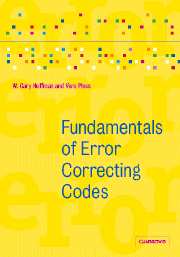Book contents
- Frontmatter
- Contents
- Preface
- 1 Basic concepts of linear codes
- 2 Bounds on the size of codes
- 3 Finite fields
- 4 Cyclic codes
- 5 BCH and Reed–Solomon codes
- 6 Duadic codes
- 7 Weight distributions
- 8 Designs
- 9 Self-dual codes
- 10 Some favorite self-dual codes
- 11 Covering radius and cosets
- 12 Codes over ℤ4
- 13 Codes from algebraic geometry
- 14 Convolutional codes
- 15 Soft decision and iterative decoding
- References
- Symbol index
- Subject index
15 - Soft decision and iterative decoding
Published online by Cambridge University Press: 05 June 2012
- Frontmatter
- Contents
- Preface
- 1 Basic concepts of linear codes
- 2 Bounds on the size of codes
- 3 Finite fields
- 4 Cyclic codes
- 5 BCH and Reed–Solomon codes
- 6 Duadic codes
- 7 Weight distributions
- 8 Designs
- 9 Self-dual codes
- 10 Some favorite self-dual codes
- 11 Covering radius and cosets
- 12 Codes over ℤ4
- 13 Codes from algebraic geometry
- 14 Convolutional codes
- 15 Soft decision and iterative decoding
- References
- Symbol index
- Subject index
Summary
The decoding algorithms that we have considered to this point have all been hard decision algorithms. A hard decision decoder is one which accepts hard values (for example 0s or 1s if the data is binary) from the channel that are used to create what is hopefully the original codeword. Thus a hard decision decoder is characterized by “hard input” and “hard output.” In contrast, a soft decision decoder will generally accept “soft input” from the channel while producing “hard output” estimates of the correct symbols. As we will see later, the “soft input” can be estimates, based on probabilities, of the received symbols. In our later discussion of turbo codes, we will see that turbo decoding uses two “soft input, soft output” decoders that pass “soft” information back and forth in an iterative manner between themselves. After a certain number of iterations, the turbo decoder produces a “hard estimate” of the correct transmitted symbols.
Additive white Gaussian noise
In order to understand soft decision decoding, it is helpful to take a closer look first at the communication channel presented in Figure 1.1. Our description relies heavily on the presentation in. The box in that figure labeled “Channel” is more accurately described as consisting of three components: a modulator, a waveform channel, and a demodulator; see Figure 15.1. For simplicity we restrict ourselves to binary data. Suppose that we transmit the binary codeword c = c1 … cn.
- Type
- Chapter
- Information
- Fundamentals of Error-Correcting Codes , pp. 573 - 614Publisher: Cambridge University PressPrint publication year: 2003



